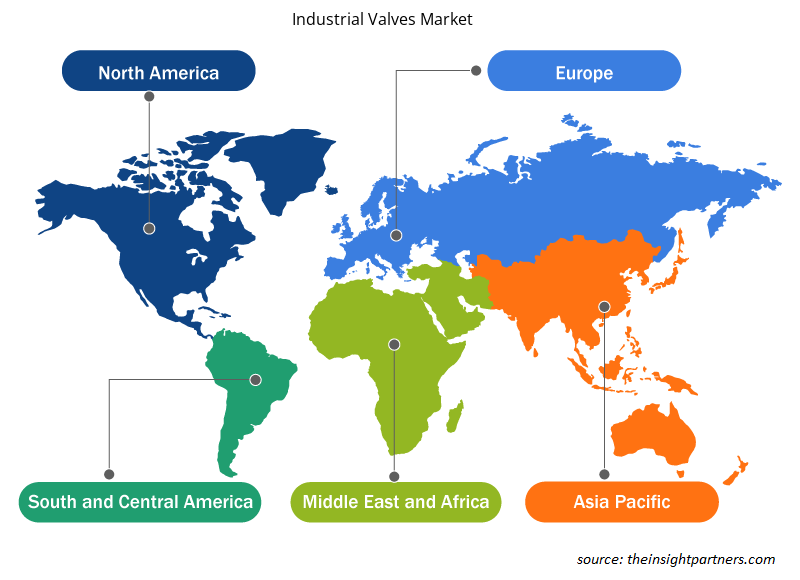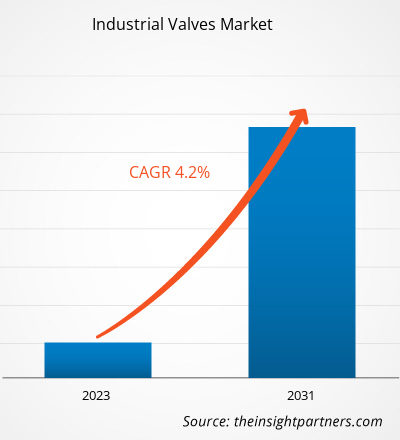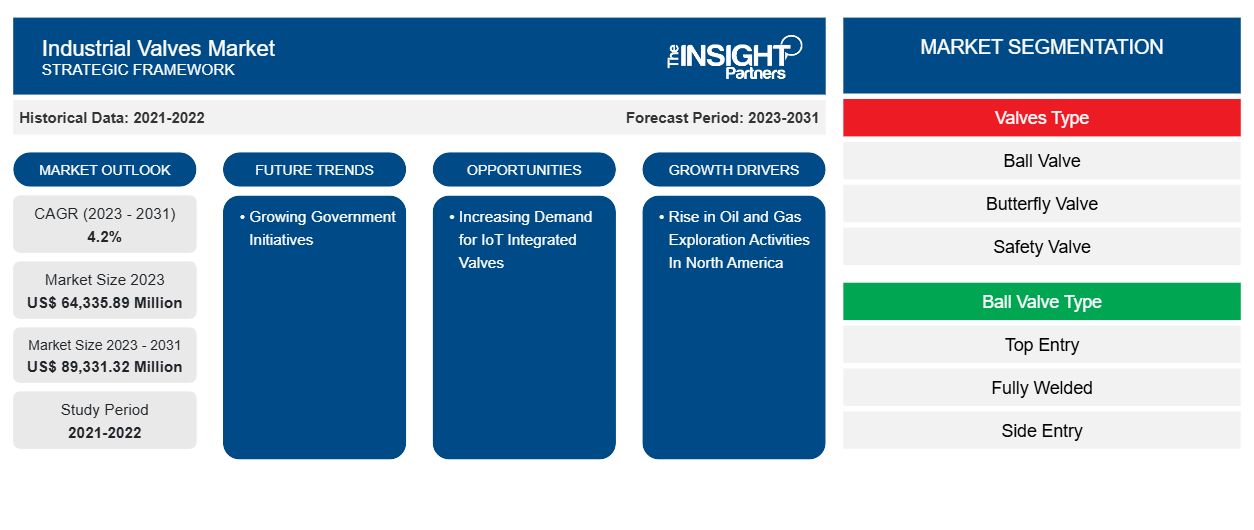Si prevede che le dimensioni del mercato delle valvole industriali raggiungeranno 89.331,32 milioni di dollari entro il 2031 da 64.335,89 milioni di dollari nel 2023, con un CAGR del 4,2% entro il 2031. Si prevede che l'aumento degli investimenti nella produzione di energia e nelle infrastrutture petrolifere e del gas in tutto il mondo aumenterà la domanda di valvole a sfera, che a sua volta dovrebbe alimentare la crescita del mercato durante il periodo di previsione. Inoltre, le iniziative di sviluppo costanti intraprese dai produttori globali di valvole a sfera stanno contribuendo alla crescita del mercato. Ad esempio, a novembre 2021, Rusco ha annunciato il lancio di una valvola a sfera intelligente e automatizzata per la filtrazione domestica, l'acqua di pozzo e le applicazioni commerciali e municipali, che può essere abbinata agli smartphone per l'automazione dei programmi e il controllo del lavaggio dei sedimenti e dell'interruzione del flusso.
Analisi del mercato delle valvole industriali
Le aziende del mercato globale delle valvole industriali si concentrano sull'offerta di prodotti nuovi e aggiornati per soddisfare le esigenze in continua evoluzione dei clienti. Ad aprile 2022, SANY UK ha lanciato la perforatrice multiuso SR235. Con un peso operativo di circa 90 tonnellate, la SR235 è alimentata da un motore Volvo Stage V, che contribuisce alla sua affidabilità ed efficienza. Nel 2019, Soilmec SpA ha introdotto nuove perforatrici SM per la fondazione di micropali e ancoraggi. A maggio 2021, l'azienda ha introdotto nuove perforatrici di medie dimensioni Soilmec SM-11 con una forza di assistenza molto elevata. Queste perforatrici presentano un'adeguata combinazione di prestazioni ed efficacia e forniscono un'impresa compatta per luoghi di lavoro con accesso limitato. Inoltre, sono facili da impostare per esigenze di lavoro diverse. A gennaio 2020, Soilmec ha acquisito una quota di maggioranza in Watson Inc., un produttore di perforatrici per fondazioni con sede in Texas, come parte di un progetto più completo volto a garantire la crescita nei mercati esteri. Pertanto, è probabile che i recenti sviluppi tecnologici e le innovazioni di prodotto nelle macchine per palificazione introdurranno nuove tendenze sul mercato nei prossimi anni.
Panoramica del mercato delle valvole industriali
Una macchina per palificazione è un gadget per impostare cumuli o pozzi nel terreno per supportare strutture compositive. Le macchine per palificazione perforano in terra limosa, terreno sabbioso e altri. Queste macchine sono utilizzate per sviluppare serbatoi d'acqua, estensioni, strutture e iniziative di stabilimento, ad esempio, fortificazione di stabilimento, divisori di stomaco e altri. Una piattaforma di ammucchiamento è una macchina di sviluppo per l'ammucchiamento in un edificio stabilito. È principalmente applicata per perforare in terreno sabbioso, fango, terra limosa e altri. È generalmente utilizzata per installare cumuli, divisori di stomaco, fortificazione di stabilimento e altre iniziative di stabilimento. Inoltre, è fondamentale considerare la posizione e la disposizione in modo soddisfacente, poiché l'aria vitale danneggerebbe o sposterebbe la macchina dalla sua posizione unica.
Personalizza questo report in base alle tue esigenze
Riceverai la personalizzazione gratuita di qualsiasi report, comprese parti di questo report, o analisi a livello nazionale, pacchetto dati Excel, oltre a usufruire di grandi offerte e sconti per start-up e università
-
Scopri le principali tendenze di mercato in questo rapporto.Questo campione GRATUITO includerà analisi di dati che spaziano dalle tendenze di mercato alle stime e alle previsioni.
Driver e opportunità del mercato delle valvole industriali
Aumento delle attività di esplorazione di petrolio e gas in Nord America
Nel settore petrolifero e del gas, le valvole di controllo industriali hanno trovato applicazione nello stoccaggio del gas naturale con intervalli di temperatura criogenici grazie alla loro capacità di funzionare in modo efficiente in impostazioni di pressione fino a 750 psi e temperature fino a -196 °C (-320 °F). Inoltre, il settore petrolifero e del gas del Nord America sta proliferando anno dopo anno grazie alla scoperta di piattaforme petrolifere e di gas. Inoltre, la produzione di gas naturale negli Stati Uniti è cresciuta in modo significativo negli ultimi anni poiché i miglioramenti nelle tecnologie di perforazione hanno reso commercialmente fattibile il recupero del gas intrappolato in formazioni solide, come scisto e carbone. Pertanto, si prevede che l'aumento dell'esplorazione e della produzione di petrolio e gas nel paese spingerà la domanda di valvole industriali, che, a sua volta, dovrebbe alimentare la crescita del mercato dal 2023 al 2031.
Iniziative governative in crescita
La cromatografia gassosa è una tecnica analitica ampiamente utilizzata in vari settori, tra cui l'industria petrolifera, per separare e analizzare i composti. Al 1° gennaio 2023, gli Stati Uniti avevano 129 raffinerie di petrolio operative. Queste raffinerie lavorano costantemente per soddisfare la domanda globale di prodotti petroliferi, il che rafforza ulteriormente il mercato delle valvole industriali. Gli Stati Uniti sono stati la seconda nazione più grande nella produzione manifatturiera e industriale dopo la Cina nel 2022. Nel 2022, l'industria manifatturiera ha contribuito con 2.300 miliardi di dollari e ha rappresentato oltre l'11% del PIL totale degli Stati Uniti. Per aumentare la produzione industriale allo stesso ritmo, è necessario aumentare gli investimenti nello sviluppo e nell'espansione delle infrastrutture, che, a loro volta, dovrebbero creare una domanda di valvole industriali nei prossimi anni. L'economia statunitense dipende da un'ampia rete di infrastrutture per mantenere la sua posizione in tutto il mondo. L'attuale infrastruttura negli Stati Uniti sta invecchiando e necessita di ammodernamento ed espansione della capacità nei settori, tra cui petrolio e gas, energia, acqua e acque reflue, tra gli altri. Secondo l'Environmental Protection Agency, si stima che il settore dell'acqua potabile e delle acque reflue necessiterà di oltre 744 miliardi di dollari di investimenti nel prossimo decennio. Ad esempio, nel 2022, gli Stati Uniti hanno approvato l'Inflation Reduction Act, finalizzato a finanziare 150 miliardi di dollari per il finanziamento delle infrastrutture per i trasporti, progetti di energia pulita e altre infrastrutture. Si prevede che tali iniziative governative per lo sviluppo e l'espansione delle infrastrutture negli Stati Uniti alimenteranno la domanda di valvole industriali, che dovrebbe alimentare le opportunità di crescita del mercato nei prossimi anni.
Analisi della segmentazione del rapporto di mercato delle valvole industriali
I segmenti chiave che hanno contribuito alla derivazione dell'analisi del mercato delle valvole industriali sono la tipologia di valvola.
- In base al tipo di valvola, il mercato delle valvole industriali è segmentato in valvole a sfera, valvole a farfalla, valvole di sicurezza, valvole di controllo, valvole di ritegno, valvole a otturatore e altre. Il segmento delle valvole di controllo ha rappresentato la quota di mercato maggiore nel 2023.
Analisi della quota di mercato delle valvole industriali per area geografica
Il mercato globale delle valvole industriali è ampiamente segmentato in Nord America, Europa, Asia Pacifico (APAC), Medio Oriente e Africa (MEA) e Sud America (SAM). L'Asia Pacifico ha dominato il mercato delle valvole industriali nel 2023 con una quota del 39,5%; continuerà a dominare il mercato durante il periodo di previsione e rappresenterà una quota del 41,9% entro il 2031. L'Asia Pacifico ha dominato il mercato delle valvole industriali nel 2023 con una quota del 39,5%; continuerà a dominare il mercato durante il periodo di previsione e rappresenterà una quota del 41,9% entro il 2031. L'Europa è il secondo maggiore contributore al mercato globale delle valvole industriali, seguito dal Nord America.
Il mercato delle valvole industriali è ampiamente segmentato in cinque regioni principali: Nord America, Europa, Asia Pacifico, Medio Oriente e Africa e Sud America. Nel 2023, l'Asia Pacifico ha guidato il mercato globale delle valvole industriali con una quota di mercato del 39,5%, seguita da Europa e Nord America. Si prevede che l'Asia Pacifico sarà la regione in più rapida crescita e dovrebbe registrare un CAGR impressionante del 5,0% dal 2023 al 2031.
Nel mercato globale delle valvole industriali, il Nord America ha occupato la terza posizione con una quota di mercato superiore al 22,0% nel 2023. Il Nord America è analizzato in base alla presenza di paesi ben sviluppati come Stati Uniti, Canada e Messico, dove le attività di esplorazione di petrolio e gas, produzione di energia e produzione stanno crescendo a un ritmo significativo. La crescente adozione di valvole industriali avanzate e migliorate guida il mercato delle valvole industriali del Nord America. Il Nord America è tra i maggiori produttori di petrolio greggio e gas naturale al mondo. Gli Stati Uniti sono il più grande produttore di petrolio al mondo, con una quota di produzione di petrolio greggio superiore al 20%. Inoltre, la presenza di diverse aziende chimiche e petrolchimiche e dei principali attori del mercato delle valvole industriali come Emerson, Inc., Cameron-Schlumberger, Flowserve Corporation e Crane ChemPharma & Energy guida il mercato delle valvole industriali del Nord America.
Approfondimenti regionali sul mercato delle valvole industriali
Le tendenze regionali e i fattori che influenzano il mercato delle valvole industriali durante il periodo di previsione sono stati ampiamente spiegati dagli analisti di Insight Partners. Questa sezione discute anche i segmenti e la geografia del mercato delle valvole industriali in Nord America, Europa, Asia Pacifico, Medio Oriente e Africa e Sud e Centro America.

- Ottieni i dati specifici regionali per il mercato delle valvole industriali
Ambito del rapporto sul mercato delle valvole industriali
| Attributo del report | Dettagli |
|---|---|
| Dimensioni del mercato nel 2023 | 64.335,89 milioni di dollari USA |
| Dimensioni del mercato entro il 2031 | 89.331,32 milioni di dollari USA |
| CAGR globale (2023-2031) | 4,2% |
| Dati storici | 2021-2022 |
| Periodo di previsione | 2023-2031 |
| Segmenti coperti |
Per tipo di valvola
|
| Regioni e Paesi coperti |
America del Nord
|
| Leader di mercato e profili aziendali chiave |
|
Densità degli attori del mercato delle valvole industriali: comprendere il suo impatto sulle dinamiche aziendali
Il mercato delle valvole industriali sta crescendo rapidamente, spinto dalla crescente domanda degli utenti finali dovuta a fattori quali l'evoluzione delle preferenze dei consumatori, i progressi tecnologici e una maggiore consapevolezza dei vantaggi del prodotto. Con l'aumento della domanda, le aziende stanno ampliando le loro offerte, innovando per soddisfare le esigenze dei consumatori e capitalizzando sulle tendenze emergenti, il che alimenta ulteriormente la crescita del mercato.
La densità degli operatori di mercato si riferisce alla distribuzione di aziende o società che operano in un particolare mercato o settore. Indica quanti concorrenti (operatori di mercato) sono presenti in un dato spazio di mercato in relazione alle sue dimensioni o al valore di mercato totale.
Le principali aziende che operano nel mercato delle valvole industriali sono:
- Velan Inc
- Società di gru
- CIRCOR International Inc
- Società Flowserve
- Emerson Electric Co
- Società KITZ
Disclaimer : le aziende elencate sopra non sono classificate secondo un ordine particolare.

- Ottieni una panoramica dei principali attori del mercato delle valvole industriali
Notizie di mercato e sviluppi recenti sulle valvole industriali
Il mercato delle valvole industriali viene valutato raccogliendo dati qualitativi e quantitativi dopo la ricerca primaria e secondaria, che include importanti pubblicazioni aziendali, dati associativi e database. Di seguito è riportato un elenco degli sviluppi nel mercato per innovazioni, espansione aziendale e strategie:
- Ad aprile 2024, Flomatic Valves, fornitore leader di soluzioni per il controllo dell'acqua, è lieta di presentare la nuova valvola di ritegno a battente modello 745SC da 3". Questa valvola è progettata per soddisfare i requisiti dello standard AWWA C508 ed è conforme alle disposizioni American Iron & Steel (AIS), garantendo prestazioni, affidabilità e versatilità superiori. (Fonte: Flomatic Valves, comunicato stampa)
- A dicembre 2021, CIRCOR International, Inc., produttore e distributore leader di prodotti e sottosistemi tecnologici differenziati, annuncia la nuova valvola di controllo CIR 3100, un corpo valvola economico con molteplici opzioni interne per numerose applicazioni in un'ampia gamma di settori. (Fonte: CIRCOR International, Inc., comunicato stampa)
Copertura e risultati del rapporto sul mercato delle valvole industriali
Il rapporto "Dimensioni e previsioni del mercato delle valvole industriali (2021-2031)" fornisce un'analisi dettagliata del mercato che copre le seguenti aree:
- Dimensioni e previsioni del mercato delle valvole industriali a livello globale, regionale e nazionale per tutti i principali segmenti di mercato trattati nell'ambito dell'articolo.
- Dinamiche di mercato come fattori trainanti, vincoli e opportunità chiave
- Tendenze del mercato delle valvole industriali
- Analisi dettagliata delle cinque forze PEST/Porter e SWOT
- Analisi del mercato delle valvole industriali che copre le principali tendenze del mercato, il quadro globale e regionale, i principali attori, le normative e i recenti sviluppi del mercato
- Panoramica del mercato delle valvole industriali e analisi della concorrenza che comprende la concentrazione del mercato, l'analisi della mappa di calore, i principali attori e gli sviluppi recenti.
- Profili aziendali dettagliati
- Analisi storica (2 anni), anno base, previsione (7 anni) con CAGR
- Analisi PEST e SWOT
- Valore/volume delle dimensioni del mercato - Globale, Regionale, Nazionale
- Industria e panorama competitivo
- Set di dati Excel
Report recenti
Testimonianze
Motivo dell'acquisto
- Processo decisionale informato
- Comprensione delle dinamiche di mercato
- Analisi competitiva
- Analisi dei clienti
- Previsioni di mercato
- Mitigazione del rischio
- Pianificazione strategica
- Giustificazione degli investimenti
- Identificazione dei mercati emergenti
- Miglioramento delle strategie di marketing
- Aumento dell'efficienza operativa
- Allineamento alle tendenze normative























 Ottieni un campione gratuito per - Mercato delle valvole industriali
Ottieni un campione gratuito per - Mercato delle valvole industriali